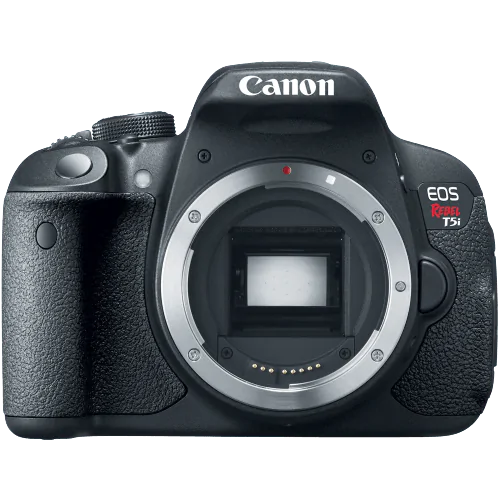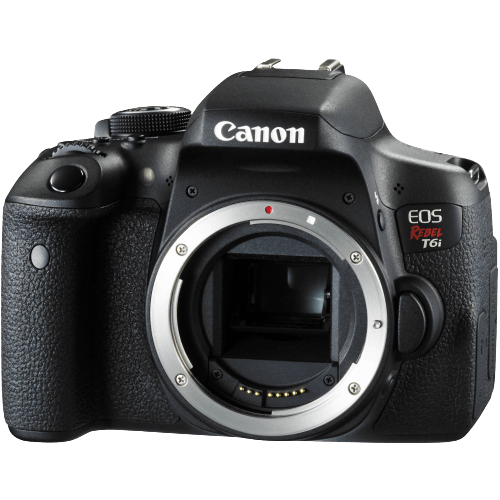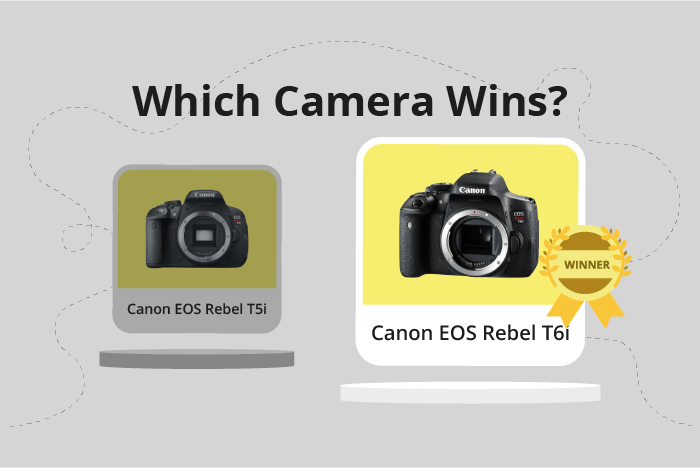Canon EOS Rebel T5i / 700D vs EOS Rebel T6i / 750D Comparison
Canon EOS Rebel T5i / 700D

Canon EOS Rebel T6i / 750D

The Canon EOS Rebel T6i / 750D emerges as the winner with a score of 56/100, compared to the Canon EOS Rebel T5i / 700D‘s score of 44/100. Both cameras share some common specifications: they are DSLR cameras, announced at a launch price of $750, and have similar dimensions.
The T6i / 750D outperforms the T5i / 700D with its lighter weight of 555g, making it more comfortable for extended use. Additionally, the T6i / 750D was released in 2015, two years after the T5i / 700D, which suggests improvements in technology and features.
However, the T5i does have a slightly larger size, measuring 133 x 100 x 79mm compared to the T6i / 750D’s 132 x 101 x 78mm. This difference may be negligible for most users, but it could be a consideration for those who prefer a slightly larger camera body.
Taking all of this into account, the T6i is the better option of the two, offering a higher score, lighter weight, and more recent release date. The T5i may still be a suitable choice for those who prefer its larger size, but the T6i / 750D’s advantages make it the clear winner.
Canon EOS Rebel T5i vs EOS Rebel T6i Overview and Optics
The Canon EOS Rebel T6i stands out as the winner in terms of optics, with a score of 59/100, compared to the Canon EOS Rebel T5i / 700D, which scored 40/100. This 19-point difference highlights the superior optical performance of the T6i / 750D.
Both cameras share some common specifications, such as a CMOS sensor, an APS-C sensor size, a Canon EF-S lens mount, and the absence of image stabilization. They also have the same shooting speed of 5 frames per second.
The T6i / 750D outperforms the T5i / 700D in several aspects. With a higher megapixel count of 24.2 compared to 18, the T6i / 750D captures more detailed images. It also has a more advanced processor, the Digic 6, which contributes to better image quality and faster processing. Furthermore, the T6i / 750D has a DXOMARK sensor score of 71, which is 10 points higher than the T5i / 700D’s score of 61, indicating better overall image quality.
The T5i / 700D does not have any significant advantages over the T6i / 750D in terms of optics. They share the same shooting speed, sensor type, sensor size, lens mount, and lack of image stabilization.
Therefore, it is clear that the Canon EOS Rebel T6i / 750D is the superior camera in terms of optics, with better image quality and processing capabilities. The T5i / 700D, while sharing some common features, falls short in comparison to its counterpart, making the T6i / 750D a more desirable choice for photographers seeking better optical performance.
Canon EOS Rebel T5i vs EOS Rebel T6i Video Performance
The Canon EOS Rebel T5i / 700D and the Canon EOS Rebel T6i / 750D have identical video scores of 43/100. Both cameras share common video specifications, including Full HD video resolution, maximum video dimensions of 1920 x 1080, and a maximum video frame rate of 30fps. Neither camera has built-in time-lapse functionality.
With the same video score and specifications, neither the Canon EOS Rebel T5i / 700D nor the Canon EOS Rebel T6i / 750D outperforms the other in terms of video capabilities. Both cameras are equally suitable for users who seek Full HD video resolution and a maximum video frame rate of 30fps.
Despite the identical scores and shared video specifications, there might be minor differences in video quality, color rendition, or other subtle nuances not reflected in the score. However, these differences are likely to be insignificant and not noticeable for the average user.
Given the similarities in video capabilities, potential buyers should consider other factors, such as price, additional features, or personal preferences, when choosing between the Canon EOS Rebel T5i and the Canon EOS Rebel T6i. Both cameras offer reliable video performance, and users can expect satisfactory results from either model.
Canon EOS Rebel T5i vs T6i Features and Benefits
The Canon EOS Rebel T5i (700D) and the Canon EOS Rebel T6i (750D) both have a feature score of 57 out of 100. This shows that these two cameras have similar features, with neither camera having a clear advantage over the other.
Both cameras share a 3-inch screen size and a screen resolution of 1,040,000 dots. They also both have a touchscreen and flip screen, making them user-friendly and versatile for different shooting situations. Neither camera has GPS or Bluetooth capabilities.
The Canon EOS Rebel T6i (750D) has an advantage over the T5i (700D) in terms of connectivity, as it features built-in Wi-Fi. This allows for easier sharing of photos and remote control of the camera using a compatible smartphone or tablet. The T5i (700D) does not have Wi-Fi, which may be a disadvantage for those who value easy sharing and remote control capabilities.
The Canon EOS Rebel T5i (700D) does not have any clear advantages over the T6i (750D). Both cameras have the same feature score and share many specifications, making the T5i (700D) a suitable choice for those who do not require Wi-Fi connectivity.
Given the similar feature scores and specifications of the Canon EOS Rebel T5i (700D) and the Canon EOS Rebel T6i (750D), the choice between the two cameras largely depends on individual preferences and requirements. The T6i (750D) offers better connectivity with its Wi-Fi capabilities, while the T5i (700D) may be suitable for those who do not require this feature.
Canon EOS Rebel T5i vs T6i Storage and Battery
The Canon EOS Rebel T5i and the T6i both have a storage and battery score of 24/100. They share several specifications, such as having one memory card slot, accepting SD/SDHC/SDXC memory cards, a battery life of 440 shots, and no USB charging capabilities.
The T6i/750D has a slight advantage in storage as it is compatible with UHS-I memory cards, providing faster read and write speeds. This makes it better for photographers who need to quickly transfer images.
There is no significant difference in battery performance between the two cameras. Both use different battery types, with the T5i/700D using an LP-E8 battery and the T6i/750D using an LP-E17 battery. However, this does not affect their battery life or overall performance.
Considering the storage and battery aspects, the T6i/750D has a minor advantage due to its UHS-I compatibility, but both cameras are largely equal in this category.
Alternatives to the Canon EOS Rebel T5i and T6i
Are you still undecided about which camera is right for you? Have a look at these popular comparisons that feature the Canon EOS Rebel T5i / 700D or the Canon EOS Rebel T6i / 750D:

